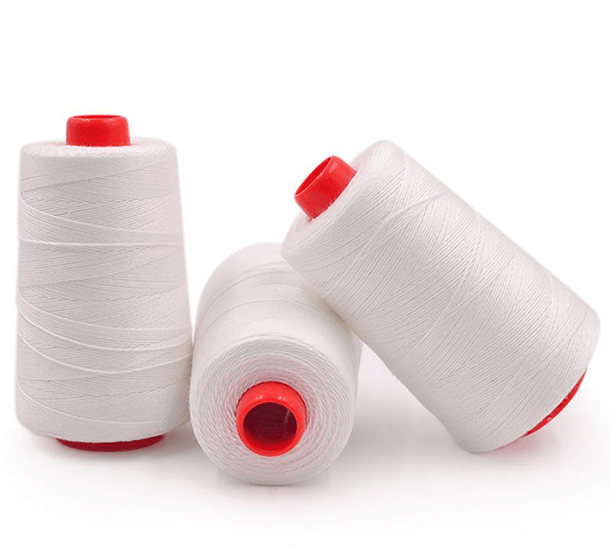Tipos de materiales para hilo de cierre de bolsas y cómo elegir

| Thread Type | Main Advantages | Main Disadvantages | Primary Application Scenarios |
|---|---|---|---|
| Polyester Sewing Thread | High tensile strength, excellent abrasion resistance, good chemical resistance, low shrinkage, cost-effective | Relatively low melting point; may melt during high-speed sewing due to needle heat | Cement, fertilizer, feed, and other heavy-duty packaging bags; the most versatile option |
| Cotton Sewing Thread | Good heat resistance, soft hand feel | Lower tensile strength, poor abrasion resistance, prone to moisture absorption and mildew | Gradually being phased out; used only for specific manual sewing or high-temperature requirements |
| Nylon (Polyamide) Thread | High tensile strength, good elasticity, excellent abrasion resistance | Poor heat resistance (softens around 120°C) | Mainly for garment sewing (e.g., synthetic fabrics, woolens); less common for bag sewing |
| Vinylon (PVA) Thread | Good heat resistance (softening point ~220°C) | Inferior anti-aging properties and smoothness compared to polyester; higher material cost | Heavy canvas, protective gear; less common in bag sewing |
| Core-Spun Thread | Combines the strength of the core filament (e.g., polyester) with the surface properties (e.g., cotton) for heat resistance/hand feel | More complex manufacturing process, typically higher cost | Scenarios demanding high strength and superior stitch appearance (e.g., premium denim) |
How to Select the Suitable Bag Closing Thread
While the table provides an overview, practical selection requires a detective's approach, considering these real-world factors:
- Consider the Packaged Contents: This is one of the most critical factors. For chemical products like fertilizers or resins, the thread must possess good chemical resistance. Polyester thread is often the preferred choice for these applications due to its excellent chemical stability.
- Assess the Sewing and Transport Environment:
- Sewing Machine Speed: High-speed sewing generates significant needle heat due to friction. Polyester thread, with its lower melting point, can be susceptible to melting and breakage. If your operation involves very high speeds, the thread's heat resistance is crucial. Cotton performs better here, but its lower strength must be considered.
- Bag Material Thickness and Weight: For sewing cement, fertilizer, and other heavy-duty sacks, heavier thread sizes like 3x3 (Ticket 30) are often required, ensuring very high tensile strength.
- Post-Sewing Temperature Exposure: If the bag will be filled with hot contents (e.g., hot cement), the thread must withstand this temperature. For instance, thread for cement bags often needs to resist temperatures up to 150°C. Both Polyester and Vinylon offer good heat resistance in this context.
- Balance Cost and Quality: Within your budget, opt for the highest quality possible. The market has inferior threads that cause frequent breakage and skipped stitches, leading to increased downtime and defect rates, which ultimately costs more.
Summary and Recommendations
In summary, for the vast majority of industrial bag sewing applications, 100% Polyester Sewing Thread is the most widely used and recommended choice due to its well-rounded performance and cost-effectiveness.
You can follow this decision process:
- Start with Polyester Thread: For most industrial packaging of grains, animal feed, cement, and fertilizers, pure polyester sewing thread is a reliable and capable choice.
- Confirm Technical Specifications: Consult with your supplier to determine the required thread size (e.g., 2x3, 3x3) based on your bag material and load capacity.
- Request Samples for Testing: Before placing a bulk order, always request samples for practical sewing tests. This is the most effective way to verify the thread's sewability (resistance to breakage/skipping stitches) and assess the final stitch quality.
- Actualizado el .